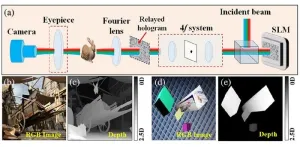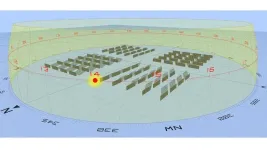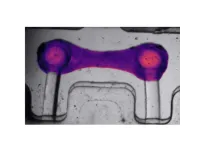(Press-News.org)
In a recent study, researchers at Huntsman Cancer Institute at the University of Utah (the U) found a surprising trend in families with male infertility: an increased risk of certain cancers. This discovery could lead to a more personalized approach to cancer risk assessments, making cancer prevention more effective.
According to the National Institutes of Health, around 9% of men at reproductive age have experienced fertility problems.
“We know that men who experience infertility tend to have more health issues like cardiovascular disease, autoimmune conditions, earlier mortality, chronic health conditions, and cancer,” says Joemy Ramsay, PhD, the study's lead investigator, researcher at Huntsman Cancer Institute, and assistant professor in the Division of Urology at the U. “We wanted to look at whether the family members of these men were at higher risk for these conditions.”
Ramsay has a background in public health, specializing in occupational and environmental exposure. This study represents the first step in determining family members’ correlated risk levels to diseases, such as cancer. Ramsay explains that since family members share similar genetic factors, environments, and lifestyles, it would be easier to identify other things impacting their cancer risk. Once general risk has been assessed, etiological factors can be more accurately evaluated in determining the part they play in a diagnosis.
Using the Utah Population Database, one of the world’s richest sources of genetic and public health information, Ramsay and her team, which included Heidi Hanson, MS, PhD, Nicola Camp, PhD, and Myke Madsen, looked at parents, siblings, children, and even aunts, uncles, and cousins, of men who have been diagnosed with infertility.
By observing several types of cancer at once, the team was able to develop an algorithm that clusters similar things together. This algorithm made it possible to identify roughly 13 characteristic patterns. The patterns were based on families possessing similar multi-cancer risks, instead of looking at only one cancer type at a time.
“Both cancer and subfertility are complex diseases and processes,” says Ramsay. “This method helps create similar family groups, making it easier to uncover the reason behind a family being at high risk for certain diseases over others.”
For families with male infertility, these findings may prompt additional conversations with their doctors.
“While the link is still not fully understood, it is important to have these conversations with our families, and bring your concerns to your medical team,” says Ramsay.
Further research is needed to continue to establish a link between male infertility and cancer risk. Understanding the reason behind a risk may ultimately lead to more personalized courses of treatment, screening, and prevention.
Huntsman Cancer Institute leads the way in educating patients on how to prevent and treat cancer. For more information on genetic testing, visit our Family Cancer Assessment Clinic.
This study was supported by the National Institutes of Health/National Cancer Institute including P30 CA042014 and Huntsman Cancer Foundation. The chatbots were developed in a recently completed trial funded by the Inherited Cancer Syndrome Collaborative of the Cancer Moonshot initiative.
About Huntsman Cancer Institute at the University of Utah
Huntsman Cancer Institute at the University of Utah (the U) is the National Cancer Institute-designated Comprehensive Cancer Center for Utah, Idaho, Montana, Nevada, and Wyoming. With a legacy of innovative cancer research, groundbreaking discoveries, and world-class patient care, we are transforming the way cancer is understood, prevented, diagnosed, treated, and survived. Huntsman Cancer Institute focuses on delivering a cancer-free frontier to all communities in the area we serve. We have more than 300 open clinical trials and 250 research teams studying cancer at any given time. More genes for inherited cancers have been discovered at Huntsman Cancer Institute than at any other cancer center. Our scientists are world-renowned for understanding how cancer begins and using that knowledge to develop innovative approaches to treat each patient’s unique disease. Huntsman Cancer Institute was founded by Jon M. and Karen Huntsman.
END
A new study by Upstate Medical University researchers shows that recreational cannabis use may offer protection against cognitive decline.
The study, done by Master of Public Health (MPH) student Zhi Chen and Professor Roger Wong, Ph.D., MPH, MSW, analyzed a large data set from the CDC and found that compared to non-users, non-medical cannabis use, such as for recreational purposes, was significantly associated with 96 percent decreased odds of subjective cognitive decline (SCD). Medical and dual (medical and non-medical) use were also associated with ...
Coronary artery disease and major depression may be genetically linked via inflammatory pathways to an increased risk for cardiomyopathy, a degenerative heart muscle disease, researchers at Vanderbilt University Medical Center and Massachusetts General Hospital have found.
Their report, published April 5 in the journal Nature Mental Health, suggests that drugs prescribed for coronary artery disease and depression, when used in combination, potentially may reduce inflammation and prevent the development of cardiomyopathy.
“This work suggests that chronic low-level inflammation may be a significant contributor to both depression ...
URBANA, Ill. – Carbon monoxide emissions from industrial production have serious consequences for human health and are a strong indicator of overall air pollution levels. Many countries aim to reduce their emissions, but they cannot control air flows originating in other regions. A new study from the University of Illinois Urbana-Champaign looks at global flows of air pollution and how they relate to economic activity in the global supply chain.
“Our study is unique in combining atmospheric transport of air pollution with supply chain analysis as it tells us where the pollution is coming ...
Holographic displays offer a promising avenue for achieving lifelike 3D reproductions with continuous depth sensation, holding potential applications in fields such as entertainment, medical imaging, and virtual reality. However, the conventional methods for generating computer-generated holograms (CGHs) rely on repetitive computations, leading to increased computational complexity and impracticality for real-time applications.
To tackle this issue, researchers from the University of Shanghai for Science and Technology (China) have introduced a novel method for CGH generation that significantly reduces computational overhead while ...
A recent analysis shows that renewable energy could be a viable alternative to diesel fuel for science at the South Pole. The analysis deeply explores the feasibility of replacing part of the energy production at the South Pole with renewable sources.
For almost as long as humans have spent time in Antarctica, the continent has been a home for science. One of the research outposts located there is the Amundsen-Scott South Pole Station. The science done there includes studies of climate change and cosmology.
Currently, ...
Cathie Biga, MSN, FACC, today became president of the American College of Cardiology and made history as the organization’s first non-physician president. She will serve a one-year term representing over 56,000 cardiovascular care team members around the world and leading the cardiovascular organization in its mission to transform cardiovascular care and improve heart health for all.
“I’m excited to bring my own set of leadership skills and perspectives to the ACC as we kick off the first year of our new Strategic Plan and celebrate the College’s 75th ...
Embargoed for release until 5:00 p.m. ET on Monday 8 April 2024
Annals of Internal Medicine Tip Sheet
@Annalsofim
Below please find summaries of new articles that will be published in the next issue of Annals of Internal Medicine. The summaries are not intended to substitute for the full articles as a source of information. This information is under strict embargo and by taking it into possession, media representatives are committing to the terms of the embargo not only on their own behalf, ...
The U.S. Department of Energy’s Office of Technology Transitions (OTT) selected Texas Innovates, a non-profit organization focused on hydrogen and carbon innovation and expansion in the greater Houston and Gulf Coast region, as one of 23 phase 1 winners of the Energy Program for Innovation Clusters (EPIC) Round 3 competition. Notably, Texas Innovates is the only Texas entity to advance to phase 2 of the competition.
“We have been working towards this day since we identified the need for energy hardware incubation in 2017 and were a finalist in 2019 for C40 Cities global competition to make Houston’s Velasco Incinerator ...
A Pulse of Innovation: AI at the Service of Heart Research
Columbia biomedical engineers use AI to build a transformative new tool to study and diagnose heart function
Understanding heart function and disease, as well as testing new drugs for heart conditions, has long been a complex and time-consuming task. A promising way to study disease and test new drugs is to use cellular and engineered tissue models in a dish, but existing methods to study heart cell contraction and calcium handling require a good deal of manual work, are prone to errors, and need expensive specialized equipment. There clearly is a critical medical ...
Despite having an overall survival rate of 94%, B-cell acute lymphoblastic leukemia (B-ALL), the most common childhood cancer, can prove challenging to treat, with survival among relapsed or resistant cases falling between 30-50%. Recent work by St. Jude Children’s Research Hospital scientists discovered which tumor cells resist treatment and why. This enabled the rational design of a combination therapy that better controlled high-risk subtypes of B-ALL in mouse models. The findings were published today in Cancer Cell.
“We found a new explanation of B-ALL ...









